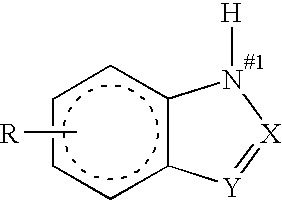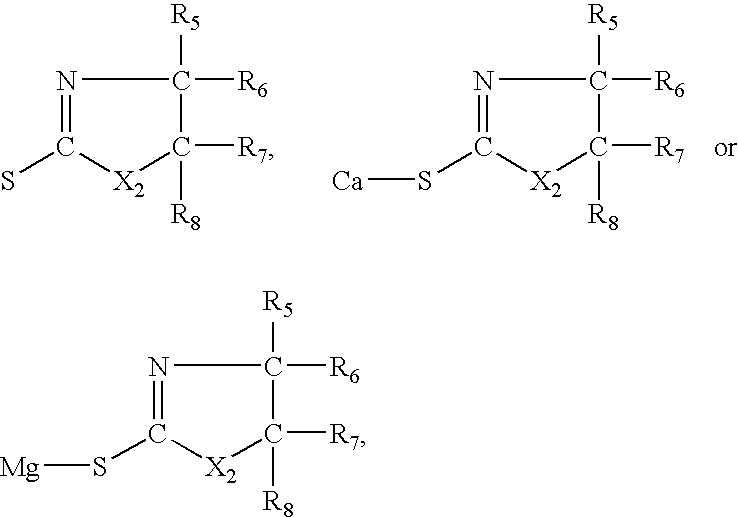Composition and method for preparing chemically-resistant roughened copper surfaces for bonding to substrates
a technology of roughened copper and surface, applied in the direction of soldering media, paper coating, dispersed particle filtration, etc., can solve the problems of difficult quality control, sensitive circuit patterns are susceptible to damage, and cannot easily bond to the dielectric layer
- Summary
- Abstract
- Description
- Claims
- Application Information
AI Technical Summary
Benefits of technology
Problems solved by technology
Method used
Image
Examples
example 1
[0104]A clean copper surface was prepared by treating a substantially clean copper surface in a pre-dip bath at 70° F. (21° C.). The pre-dip bath comprised 1.15 wt % H2O2, 0.05 wt % sodium phenolsulfonate, 0.13 wt % H2SO4, 0.18 wt % benzotriazole (1.8 g / l), balance deionized water. The clean copper surface was removed from the pre-dip bath after one minute.
[0105]The clean copper surface was then treated in a bath comprising 1.42 wt % H2O2 (oxidizer), 0.06 wt % sodium phenolsulfonate (H2O2 stabilizer), 8.61 wt % H2SO4 (pH adjuster), 0.57 wt % benzotriazole (“BTA”) (topography modifier), 0.0017 wt % NaCl (chloride ion), 0.38 wt % polyethylene glycol, balance deionized water (see Table 1). The bath temperature was maintained at 100° F. (38° C.). The copper surface was removed from the bath after one minute, rinsed with deionized water, and dried with an air hose. A roughened texture was observed on the copper surface, as is consistent with an alternative oxide coating process. Using an...
example 2
[0106]A clean copper surface was treated in a bath comprising 1.42 wt % H2O2, 0.06 wt % sodium phenolsulfonate, 8.61 wt % H2SO4, 0.57 wt % BTA, 0.0017 wt % (17 ppm) NaCl, 0.38 wt % polyethylene glycol, 1 ppm sodium diethyl-dithiocarbamate (“SDDC”) (a coating stabilizer), balance deionized water (see Table 1). The bath temperature was maintained at 100° F. (38° C.). The copper surface was removed from the bath after one minute, rinsed with deionized water, and dried with an air hose. A roughened texture was observed on the copper surface, as is consistent with an alternative oxide coating process. Using an eye-dropper, a solution containing 15% by volume hydrochloric acid was applied to the roughened surface. The roughened surface dissolved over the course of 10-20 seconds, revealing bare copper beneath. The fact that the surface did not dissolve immediately demonstrates that the roughened surface was more chemically resistant than the roughened surface of Example 1, which was not pr...
example 3
[0107]A roughened copper surface was prepared in the same manner as Example 2, with the exception that the bath contained 5 ppm SDDC (see Table 1). Upon applying a 15% hydrochloric acid solution, the roughened surface dissolved over the course of 20-30 seconds, revealing bare copper beneath. The increased time for the roughened surface to dissolve demonstrates the improved chemical resistance of the surface.
PUM
| Property | Measurement | Unit |
|---|---|---|
| Fraction | aaaaa | aaaaa |
| Fraction | aaaaa | aaaaa |
| Fraction | aaaaa | aaaaa |
Abstract
Description
Claims
Application Information
 Login to View More
Login to View More - R&D
- Intellectual Property
- Life Sciences
- Materials
- Tech Scout
- Unparalleled Data Quality
- Higher Quality Content
- 60% Fewer Hallucinations
Browse by: Latest US Patents, China's latest patents, Technical Efficacy Thesaurus, Application Domain, Technology Topic, Popular Technical Reports.
© 2025 PatSnap. All rights reserved.Legal|Privacy policy|Modern Slavery Act Transparency Statement|Sitemap|About US| Contact US: help@patsnap.com



